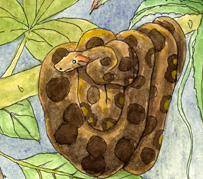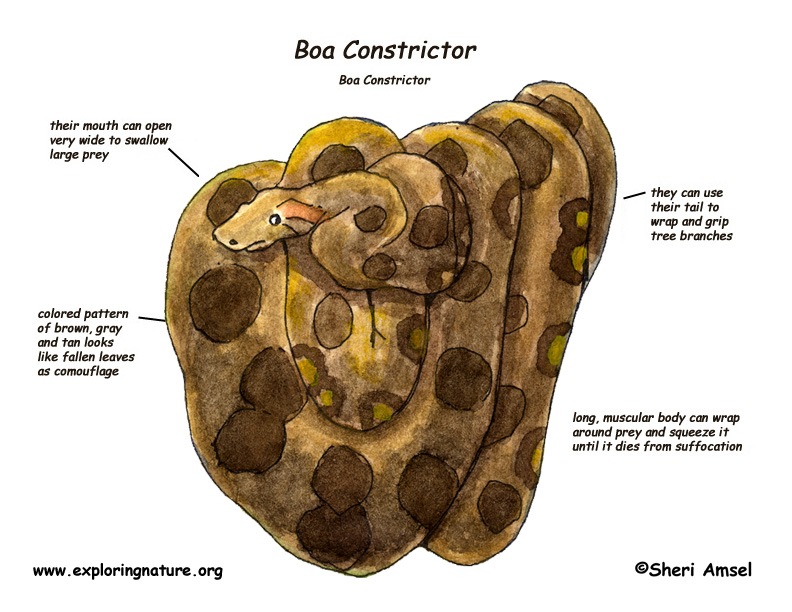

They are found from Mexico through South America and the Lesser Antilles (islands off the coast of South America).
They live mostly in the rainforest, but they can be found on grasslands, farms and on rocky hillsides.
They can be from 3 - 20 feet long and reach 100 pounds, though most are smaller. They are colored in patterns of brown, gray and tan that look like fallen leaves. This helps them blend in (camouflage). They can use their tails to grip branches. This is called a prehensile tail. They have no fangs or venom.
They live alone, except in breeding season. They are good climbers, so are often found in trees. Unlike anacondas, they don’t like to spend a lot of time in the water, though they are good swimmers. When it is colder, they slow down, but don’t hibernate. They can live up to 30 years.
They start out eating mice, birds, lizards, and frogs. As they get bigger, they begin to eat bigger prey like; monkeys, capybaras, agoutis, caimans, and wild pigs. The boa waits for prey to come to the river to drink. The boa constrictor kills it by squeezing it to death (constriction). It coils its body around it, and each time the prey breathes out, the boa squeezes tighter and tighter. Soon its prey can’t take a breath at all and dies. The boa swallows them whole. Since the boa is cold-blooded and moves so slowly, it does not need a lot of food. After eating large prey, they may not eat again for a long time.
Man is the adult boa constrictor's only enemy. Young boas are eaten by coatis, hawks, caimans, and wild pigs.
They have up to 60 live babies. The females keep the eggs inside her until they hatch at birth (This is called ovo-viviparous). She doesn’t eat while she is carrying the eggs.
Kingdom: Animalia
Phylum: Chordata
Subphylum: Vertebrata
Class: Reptilia
Order: Squamata
Suborder: Serpentes
Family: Boidae
Genus: Boa
Species: B. constrictor
When you research information you must cite the reference. Citing for websites is different from citing from books, magazines and periodicals. The style of citing shown here is from the MLA Style Citations (Modern Language Association).
When citing a WEBSITE the general format is as follows.
Author Last Name, First Name(s). "Title: Subtitle of Part of Web Page, if appropriate." Title: Subtitle: Section of Page if appropriate. Sponsoring/Publishing Agency, If Given. Additional significant descriptive information. Date of Electronic Publication or other Date, such as Last Updated. Day Month Year of access < URL >.
Amsel, Sheri. "Boa Constrictor" Exploring Nature Educational Resource ©2005-2024. December 13, 2024
< http://exploringnature.org/db/view/505 >

